Preview of the Ocean Film Festival’s First Virtual World Tour
![]()
DIVE Report
The Ocean Film Festival World Tour is returning for 2020 in its first virtual edition, with a brand-new collection of ocean-themed films arriving on the UK’s shores in October and November.
The online film evenings will involve a collection of short films ‘telling stories of seafaring adventure, carefree characters and mind-blowing marine life from the depths of the big blue; wild nautical voyages, captivating coastal scenery and stunning cinematography – all from the comfort of your sofa.’
‘It’s time to celebrate the world’s incredible oceans, and we’re thrilled to be presenting the Ocean Film Festival 2020 in this exciting new format,’ said tour director Nell Teasdale. ‘From rowing 4,000 miles across the Atlantic to surfing the spectacular cold-water waves of British Columbia, this inspirational collection of films is guaranteed to whet your appetite for an ocean adventure.’
To accompany the films, delivered from the Ocean Film Festival’s new ‘Backyard Theatre’, viewers will have exclusive access to behind-the-scenes footage and Q&A sessions with some of the film-makers. A live prize draw will be held with viewers able to win a range of ocean-related prizes.
The two shows will be held on 25-27 October and 17-19 November. The films will start at 7.30pm, but audience members are invited to explore the ‘virtual foyer’ from 6.30pm onwards, where they can download the tour magazine, enter the prize draw, and take part in an Ocean Film Festival quiz, among other activities. The shows will be available online for 48 hours for those unable to join the live broadcast.
‘While we are unable to join ocean-lovers live in theatres, we are really excited to be presenting our first-ever virtual Ocean Film Festival,’ said Teasdale. ‘So grab the popcorn, make a brew, get your friends watching at the same time – we can’t wait to ‘virtually’ see you for a night of inspiration!’
The Ocean Film Festival World Tour originated in Australia, with the aim of inspiring people to explore, respect, enjoy and protect the world’s oceans. It has toured the UK & Ireland for the last six years, working to promote the Marine Conservation Society and Surfers Against Sewage environmental charities.
Check out the highlights and trailer below – for more information and to book tickets, visit www.oceanfilmfestival.co.uk.
Highlights from the 2020 Ocean Film Festival
|
Ocean Valour
Lifelong friends Tom Rainey and Lawrence Walters set out from Manhatten, New York, to row 4,000 miles across the North Atlantic to Salcombe in Devon. Battling 80ft waves, brutal sleep deprivation, jellyfish, sharks and some unpleasant fungus, the young Brits spend a gruelling 93 days at sea, breaking two world records and raising over £130,000 for the Brain Tumour Charity in memory of Tom’s dad. Bare Existence
Polar Bears International (PBI) is a team of scientists dedicated to protecting polar bears and their habitat. In Bare Existence, a documentary film crew spends seven days with the PBI team as they research and live alongside these magnificent yet endangered creatures, known as the Kings of the Arctic. Camel Finds Water
Sometimes the biggest dreams have the humblest origins. When surfer Trevor Gordon discovers the remains of a tiny dilapidated boat in a landlocked field, he dreamed of restoring it to its original glory and sailing it to find remote waves in British Columbia. But after 1,000 hours of work, will Camel be up to the challenge?
|
A Guide to the Top Aerial Cameras for Underwater Photographers

The MV Oceania in Papua New Guinea. Original image shot by Steve Jones with a DJI Mavic Air 2 (DJI Mavic Mini pictured top right)
Aerial photography has become an essential part of the travelling photographer’s repertoire. Mark ‘Crowley’ Russell takes a look at some of the best drones for the photographer who wants to shoot both above and below the waves
What better way to contextualise the scuba diving experience than by capturing the vast expanse of turquoise blue tropical waters over the reefs surrounding the island you’ve just dived? Soaring high above while your awestruck dive buddies look over your shoulder as you pilot your craft with expert skill and land it smoothly on the… over the… in the… Oh, bother!
There are many drones on the market today, from cheap toys for kids to professional aircraft used by film crews. If you’re looking to take some quality aerial shots on holiday, however, then you’ll need something lightweight and portable with, of course, a decent camera. You can buy small drones with HD video cameras for as little as £50 but, as DIVE correspondent, expert photographer and drone enthusiast Steve Jones explains, skimping on price may not be the most cost-effective solution.
‘The main thing divers should look for when buying a drone is ease of operation,’ says Steve. ‘Cheaper drones actually rely on a far higher degree of pilot skill to control, whereas higher-end drones have so many flying aids built in that they can almost fly themselves. Given that divers may find themselves taking off from and trying to land on a boat, we should therefore invest in one that is as easy to fly as possible.’
Seasoned photographers may want to base their purchase around the camera quality, rather than the aircraft element, but the tradeoff for a higher-standard camera is a less portable drone requiring its own flight case, which many divers will already have reserved for their underwater cameras. Fortunately, there are some fantastic camera drones available that are well-suited to travelling divers, without having to invest in an aircraft of your own to transport them around the world. Some are even waterproof!
| Important: Different countries have different laws regarding the use of drones, where they can be flown, and whether or not you need training. Some have banned drones entirely, while others require advance registration with the relevant national civil aviation authority. Make sure you know what the current laws are before you travel, otherwise you may be parted from your drone by the nice people at customs. |
DJI Mavic Mini £369

DJI is widely regarded as the industry leader and its Mavic Mini is an ideal entry-level camera drone that will still appeal to more experienced photographers. Weighing in at just 249g and with folded dimensions of 140x82x57mm, the Mini is only marginally heavier than the average smartphone and not a great deal larger. As an added bonus, it comes in under the 250g registration threshold in the UK and US, meaning you can fly it straight out of the box. The 1/2.3-inch sensor of the 12MP camera only shoots in JPG and the maximum video resolution of 30fps at 2.7K falls short of more expensive models. A 30-minute flighttime ranks highly and a range of 4km is possible but, given its size, not recommended. The Mini has some excellent quick-shot shooting modes but is lacking in collision avoidance sensors and some of the better flight-tracking features. The Mavic Mini is a lot of drone for a modest price tag, and an extra £90 will get you a ‘Fly More’ bundle with extra batteries, spare parts, a prop guard and a carry case.
Pros: Ultra lightweight, great price
Cons: Limited flight features, no 4K video
www.dji.com
www.heliguy.com (UK & USA)
Parrot ANAFI £629.99

The ANAFI 4K drone weighs just 320g and unfolds in a matter of seconds, but still has a 25-minute flight time with a top speed of 33mph. The camera has a 1/2.4-inch sensor with f/2.4 aperture mounted on a gimbal with a 180-degree vertical tilt, allowing for different possibilities with shooting perspectives. Video resolution is up to 30fps in 4K and 60fps in FHD with ‘lossless’ digital zoom (no reduction in image quality) of up to 2.8x in HD and 1.4x in 4K. The ANAFI flight controller comes with a number of sophisticated pre-programmed aerial effects and an open-source SDK for developers to create their own – but it lacks collision avoidance sensors, meaning there’s a good chance it might fly into something if you’re not paying attention. A First-Person Viewer upgrade kit with cockpit goggles comes in at a bargain £100 over the price of the drone itself, and the drone is also available in ‘Work’ and ‘Extended’ packages with extra batteries and other accessories. A thermal imaging version of the ANAFI is available, priced at £2,040.
Pros: Compact, lightweight, 180-degree gimbal
Cons: No collision avoidance
DJI Mavic Air 2 £769

Released in April 2020, the Mavic Air 2 sacrifices a little of DJI’s 2018 flagship Mavic 2 Pro’s photographic capability for a 40 per cent weight saving, smaller dimensions, and superb video. The camera’s 1/2-inch sensor is limited to a fixed f/2.8 aperture and is less suited to lower light levels than the Mavic 2 Pro, but with a maximum 48MP resolution and a range of HDR features, is nevertheless capable of very high-quality imaging. The Air 2 can shoot video at 4K/60fps and in slow motion up to 240fps in 1080HD, plus an 8K ‘Hyperlapse’ flight mode for dramatic high-resolution, slow-panning timelapse footage. A maximum flight time of 34 minutes – the longest of all the Mavic family of drones – provides plenty of opportunity to capture the action. Upgraded tracking features provide a smooth and reliable experience when following subjects and avoiding obstacles, and at 570g and a 180x97x84mm folded size, the Air 2 is coat-pocket-portable if you’ve run out of luggage space. £180 gets you the Fly More combo with extra batteries, flight controller, spare propeller blades and other accessories.
Pros: Portability, battery life, flight and imaging features
Cons: Controller’s a bit bulky
www.dji.com
www.heliguy.com (UK & USA)
SwellPro Spry+ £934

The SwellPro Spry+ is one of the only completely waterproof aerial camera drones available on the market, designed to survive a 1m-deep dunking before returning to the surface, thanks to its positive buoyancy. The 12MP JPG-only camera has a 1/2.3-inch sensor and shoots video from 720p/240fps to 4K/30fps, with several automated flight modes available for dramatic photography. The ‘return to me’ feature returns the drone to the position of its flight controller instead of a pre-programmed location, a useful feature on a moving boat. Flight time is 15-17 minutes, with a range of 800m which is not as much as other leading drones and it does not fold into a more compact shape for transport. Dimensions of 233.5x249x90mm mean it will take up a bit of extra space compared to others, but at 780g with the battery fitted, not so much in the way of weight, and a lightweight carry-case is included in the price. This is a drone that you don’t have to worry about drowning, and perfect for those who enjoy surfing, water-skiing, white-water rafting and haring around on jet skis, knowing their personal automated videographer won’t mind getting splashed.
Pros: It’s waterproof!
Cons: Reduced flight time, less compact
PowerVision PowerEgg X Wizard £1,099

A good combination of versatility, portability and water resistance, the PowerEgg X doubles as a hand-held AI camcorder to which propellers can be affixed to turn it into a drone. A water-resistant coating makes it capable of flying through heavy rain straight from the box, with the Wizard package adding seaplane-style floats for water landings and a waterproof housing to protect the camera from surface splashing – but the overall package is not watertight and will come out worse for wear if dunked. The 12MP camera has a 1/2.8-inch sensor with a wide f/1.8 aperture, making it okay for photography and it does shoot in both JPG and RAW. The PowerEgg shoots video up to 240fps in HD and 60fps at 4K and pretty much every possible frame rate in between, coupled with a host of automated cinematic tracking manoeuvres. The camera’s artificial intelligence can track the operator with facial recognition technology and can learn different gestures to control different functions. The Egg weighs in at 522g in camera mode and 862g in drone mode (without the waterproof floats and housing). A length of 165mm and diameter of 100mm means it is eminently portable.
Pros: Water resistance and landings, superstar video capability
Cons: Fairly ordinary still photography
DJI Mavic 2 Pro £1,349

DJI’s game-changing 2018 flagship Mavic 2 Pro carries a Hasselblad camera with a 1-inch sensor, adjustable f/2.8-f/11 aperture, ISO range of up to 12,800, access to a 10-bit Dlog-M colour profile and 10-bit HDR video. In short, it is a high-quality compact camera that flies, and significantly better for imaging in low-light conditions than any of its competitors. Its video capabilities fall a little short of the new Mavic Air 2, with HD possible up to 120fps and 4K at 30fps, but the lack of a 60fps option at 4K is offset somewhat by the suite of intelligent flight modes, including four hyperlapse (panning timelapse) modes, all enhanced by omnidirectional obstacle avoidance sensors. At 907g it’s heavier than the Air 2 but with a folded size of 214x91x84mm, still light enough and small enough not to take up too much room in your luggage. A maximum flight time of 31 minutes affords plenty of time to take advantage of its 18km range, with speeds of up to 72km/h (45mph) possible in sport mode. A wide range of accessories is available with the Fly More combo priced at £339. This is a drone for serious photographers, not people who just want to take nice pictures.
Pros: Still photograph capability
Cons: Lacks 4K/60fps
www.dji.com
www.heliguy.com (UK & USA)
by Adam Hanlon
A Field Guide to Blackwater Diving in Hawai‘i by Jeff Milisen is available to pre-order now. It has images and descriptions of over 300 blackwater species accompanied by the author’s own observations. Jeff describes his goal as: “Each epipelagic creature is given five minutes in the spotlight to explore a little of what we know about them.”
It is available for pre-order now at www.mutualpublishing.com at special price $15.99 (retail $19.95) with an expected shipping date on 15 October.
News Release
A Field Guide to Blackwater Diving in Hawai‘i
Jeff Milisen
A Field Guide to Blackwater Diving in Hawai‘i will satisfy the curious ocean aficionado with a photographic overview of life in the open ocean at night with field guide information on each luminescent creature.
Available for pre-order at www.mutualpublishing.com at special price $15.99 (retail $19.95)
Honolulu—The world’s greatest migration of animal life occurs every evening when uncountable numbers of mostly small marine organisms rise up from the dark, chilly depths of the open ocean to its surface waters. The people who witness this nighttime migration are blackwater divers— brave divers who throw themselves off a boat in the dark of night in open ocean waters that are, for all practical purposes, bottomless. The animals that we encounter range in size from baby squids smaller than a pinky nail to forty-foot long jellyfish called siphonophores.
Some of these creatures are delicate enough to be destroyed by bubbles while others are muscular, fast, and sometimes even dangerous. Some spend their whole lives drifting near the surface, while others eventually settle on the bottom or venture freely between deep and shallow water. Schools of exotic squids and marvelous larval fishes are normal in the middle of the ocean. As strange as these animals seem to us, they help form the dominant community covering over seventy percent of the earth’s surface.
Kona, on the Island of Hawai‘i, is the birthplace and world headquarters for blackwater diving and is where I observed all the animals in this book. Its proximity to deep water and favorable ocean conditions make Hawai‘i the perfect place for blackwater diving, but divers can also visit places such as Florida, the Philippines, Indonesia, and even Papua New Guinea to see many similar animals.
Blackwater Diving in Hawai‘i is designed to satisfy the curious ocean aficionado by presenting beautiful photos and information on over 300 strange pelagic animals, most of which you won’t find in a standard field guide to reef animals. This book is intended to present an overview of life in the open ocean at night. Each epipelagic creature is given five minutes in the spotlight to explore a little of what we know about them. It is my hope that this will make plankton identification more available and palatable to the general public. In addition to my photos and some basic research on each organism, I have sprinkled my own observations throughout.
So come explore an amazing world that can seem as foreign as a distant galaxy, yet it exists just a few miles from our shoreline.
About the Author
Jeff is equal parts marine biologist, freelance writer, and underwater photographer. Jeff earned a Masters in Molecular Biosciences and Bioengineering from the University of Hawai‘i-Manoa while working with changes in the venom composition of cone snails. He went on to publish a peer-reviewed article on predictors affecting the species composition found on blackwater dives in Pacific Science. His underwater photography has been published in countless periodicals and placed in 13 international competitions. He now resides in Kona, Hawai‘i, and enjoys traveling internationally every chance he can get.
Connect with Jeff online: Twitter: @JeffMilisen Instagram: @JeffMilisen Website: iphotograph.fish
6 x 9 in. • softcover • full color • 288 pages • $19.95
by Adam Hanlon
On Wetpixel Live, Wetpixel Editor Adam Hanlon outlines the different types of image format that are common when capturing and editing pictures. He offers advice on when to use each and the pros and cons.
If you enjoy this episode, please subscribe to the Wetpixel Live YouTube Channel. This will then notify you when additional episodes are posted in future. Wetpixel Live is crammed full of hard-edged technical information and practical advice aimed at helping people create memorable images.
You’ve heard of Guam, Yap, Palau, and Truk. But if you’re planning a trip to the Federated States of Micronesia, the scuba diving in Kosrae is not to be missed. In fact, many visitors say Kosrae reminds them of Kauai in the 1960s — but the diving in these mid-Pacific, crystal-clear waters is way better.
Where is Kosrae?
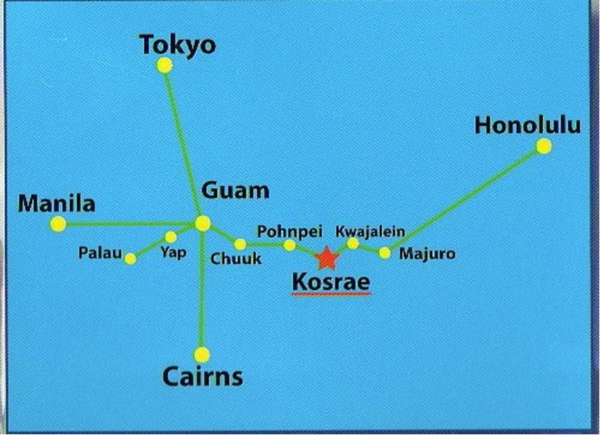
This map shows you that it’s nearly 3,000 miles (4,828 km) southwest of Honolulu, Hawaii; over 2,756 miles (4,435 km) northeast of Cairns, Australia; 2,542 miles (4,707 km) east of Manila, Philippines; and 373 miles (600 km) north of the Equator. In other words, it’s in the middle of some of the world’s most phenomenal diving.
It’s well worth the time and effort to reach this 43 square mile (110 sq. km) island, where you can expect waters hovering around 84 F (27 C) year-round and visibility of 100 to 200 feet (33 to 66 m) on most dives. Reefs teem with fish, and feature over 200 types of coral and huge, indigenous blue clams.
Here are the five of the most popular moored sites among approximately 50 sites surrounding this tropical island’s coral atoll.
Hiroshi Point
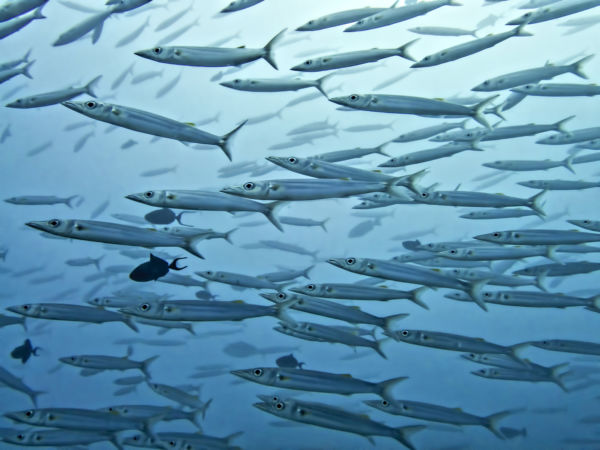
Where is it? Hiroshi Point sits on the southern end of Kosrae
What makes it special: Drift along on a mild current above an incredibly picturesque wall, gently kicking your way along to gaze at barracuda, hawksbill turtles and jellyfish. There are more kinds of soft and hard coral than you can count, and sergeant majors, surgeonfish, parrotfish and clownfish peeping out of anemones are common as well.
Details: The island’s three dive operators tie up at this buoy. Like other Kosrae sites, this is a shallow dive of about 40 feet (13 m) and is suitable for divers of any level, as well as snorkelers.
When to go: Anytime. You’ll find less wind and lighter currents from June through October, while November through May are typically windier, which limits diving on the south and west sides of the island.
Trochus Sanctuary
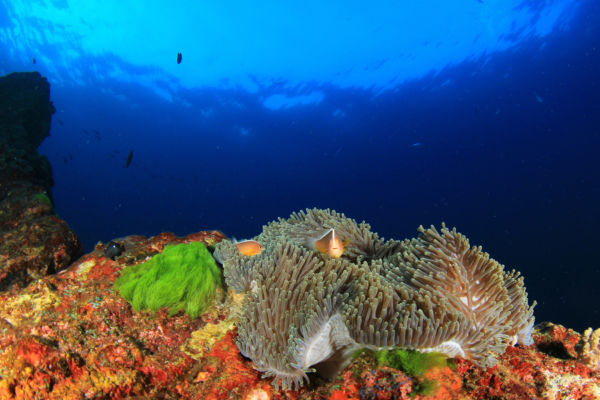
Where is it? North of the mid-point of Kosrae; southwest of the airport
What makes it special: If you love feeling like you’re diving in an aquarium, this is the dive for you. Dive into this crevasse that runs perpendicular to shore and spot clownfish, green and yellow wrasse, a variety of parrotfish and surgeonfish, blue tang, butterflyfish, angelfish, and many others. Polyclad flatworms and nudibranchs also frequent this site.
Details: This is another fairly shallow dive site at 38 feet (13 m) maximum. Hard and soft coral also abound.
When to go: See above
Shark Island
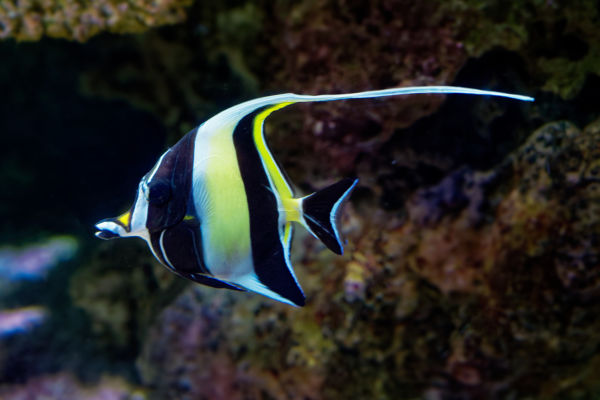
Where is it? North of the mid-point of Kosrae, near Trochus Sanctuary
What makes it special: This is another drift dive that runs along a pretty vertical wall packed with colorful soft corals on each successive rocky outcropping. As with other reefs in the area, this site is absolutely teeming with small tropical fish such as wrasses, different varieties of parrotfish, Moorish idols, clownfish, spotted trunkfish, and huge blue clams, which are indigenous to the area.
Details: This is yet another shallow dive site at 30 feet (10 m) maximum.
When to go: See above
Walung Drop-Off
Where is it? Off the southwest side of Kosrae
What makes it special: With a more sheltered location, this site provides an easy drop down the mooring line into a hard-coral garden. You can see overlapping hard corals of different colors, popcorn shrimp, and again, and dozens of species of tropical fish everywhere you look.
Details: This is a shallow dive site at 30 feet (10 m) maximum.
When to go: See above
Blue Hole
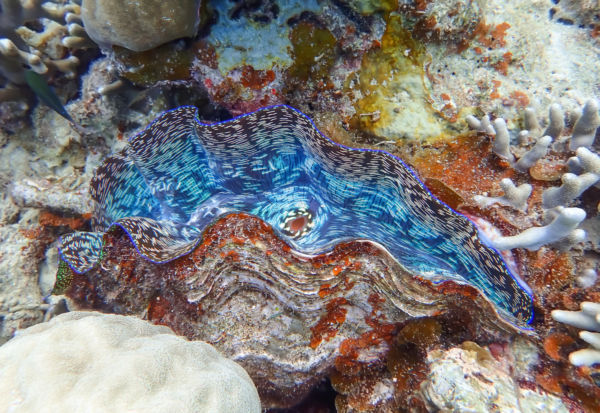
Where is it? Off the northeast shore
What makes it special: This large, natural hole lined with coral is 60 feet deep (20 m), was specifically aimed at attracting snorkelers, but is now also popular with divers. As a gap in the reef, it attracts lots of tropical fish, pufferfish, stingrays, and juvenile fish that float over at high tide and drop in. Visibility varies depending on the tides.
Details: This site is a 600 foot (200 m) walk away from or an easy swim across the reef flat in front of one of the island’s four hotels. Carved out of the reef, this is a very well protected site that is immune to high currents from stormy weather.
When to go: See above
Other popular dive sites on Kosrae include Yela Wall, Malem Reef, Bully Hays Rack, Plane Wreck, and Walung Coral Garden.
Author Gil Zeimer took a scuba resort course on Grand Cayman in 1981. He’s been hooked ever since and has explored the underwater world from Australia to Micronesia to Aruba, almost exclusively in warm waters. As a travel writer, journalist, and advertising writer, Gil is passionate about helping diving industry clients promote their sites, resorts, and causes. He lives in Tiburon, California, which is Spanish for “shark.” Find out more about him here or follow him on Facebook.
Share this:
by Adam Hanlon
Alex Mustard and Adam Hanlon chat about some of the creative options that using vintage lenses can provide for underwater photographers in this episode of Wetpixel Live. Alex kindly shares some of his imagery that illustrate some ideas about how you can use them to create different, noticeable pictures.
Wetpixel Live is a series of video episodes, providing answers to common problems experienced by underwater photographers and discussion about topics and equipment that are relevant to the underwater imaging community. Please subscribe to the channel to receive notifications when new episodes are added.
Interesting Info
 Private Scuba Tuition – Learn Scuba Skills.
Private Scuba Tuition – Learn Scuba Skills.
Joey Ridge offers private scuba diving training for those who would feel more comfortable in a private one to one setting
Diving Services
- Beginner Diving
- Padi Recreational Courses
- Padi Technical Courses
- Professional Instructor Courses
- Dive Equipment Servicing
Contact Me
Contact: Joey Ridge
PADI Course Director
TecRec Instructor Trainer
Tel: +357 99676216
Whatsapp – Facetime – Skype


